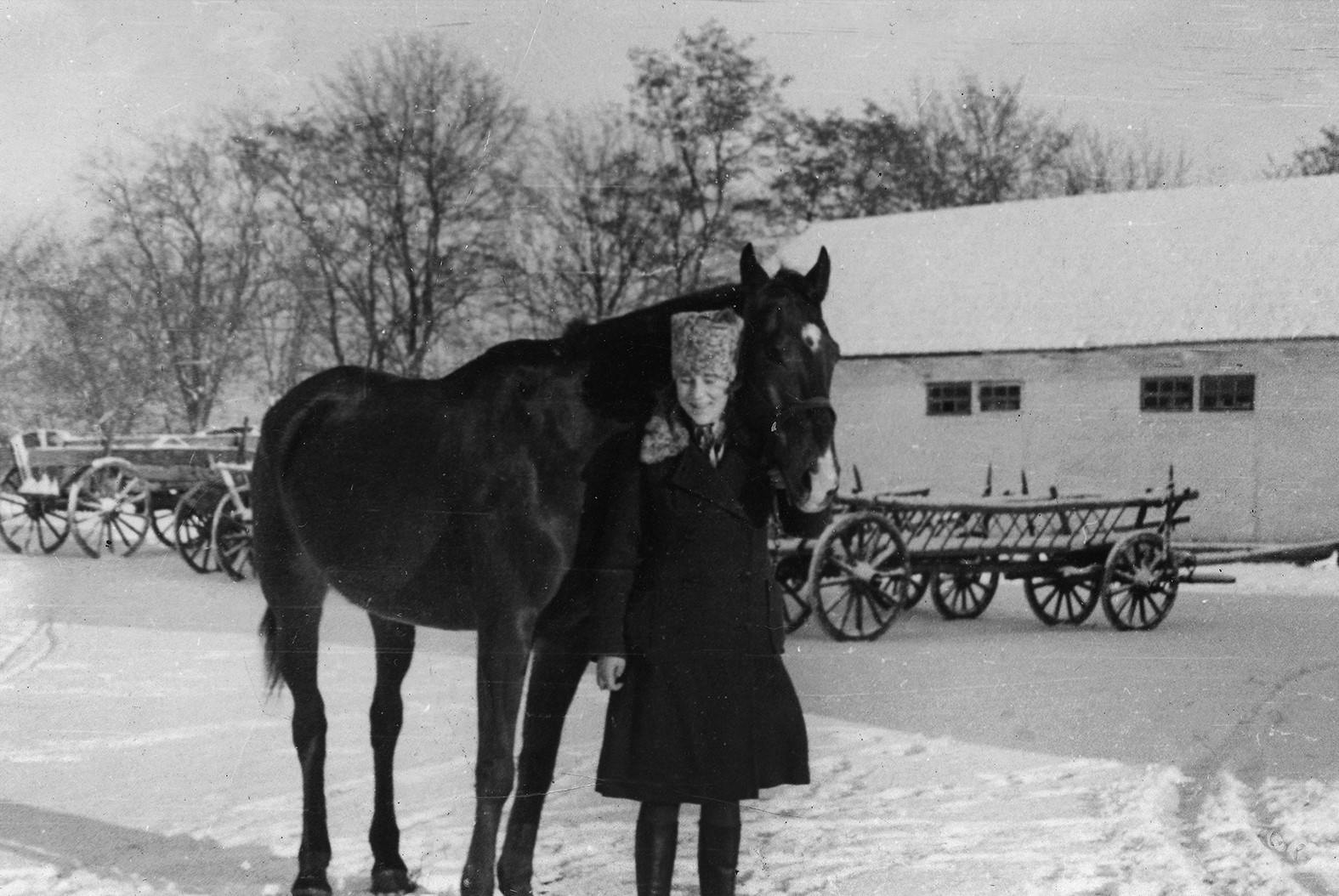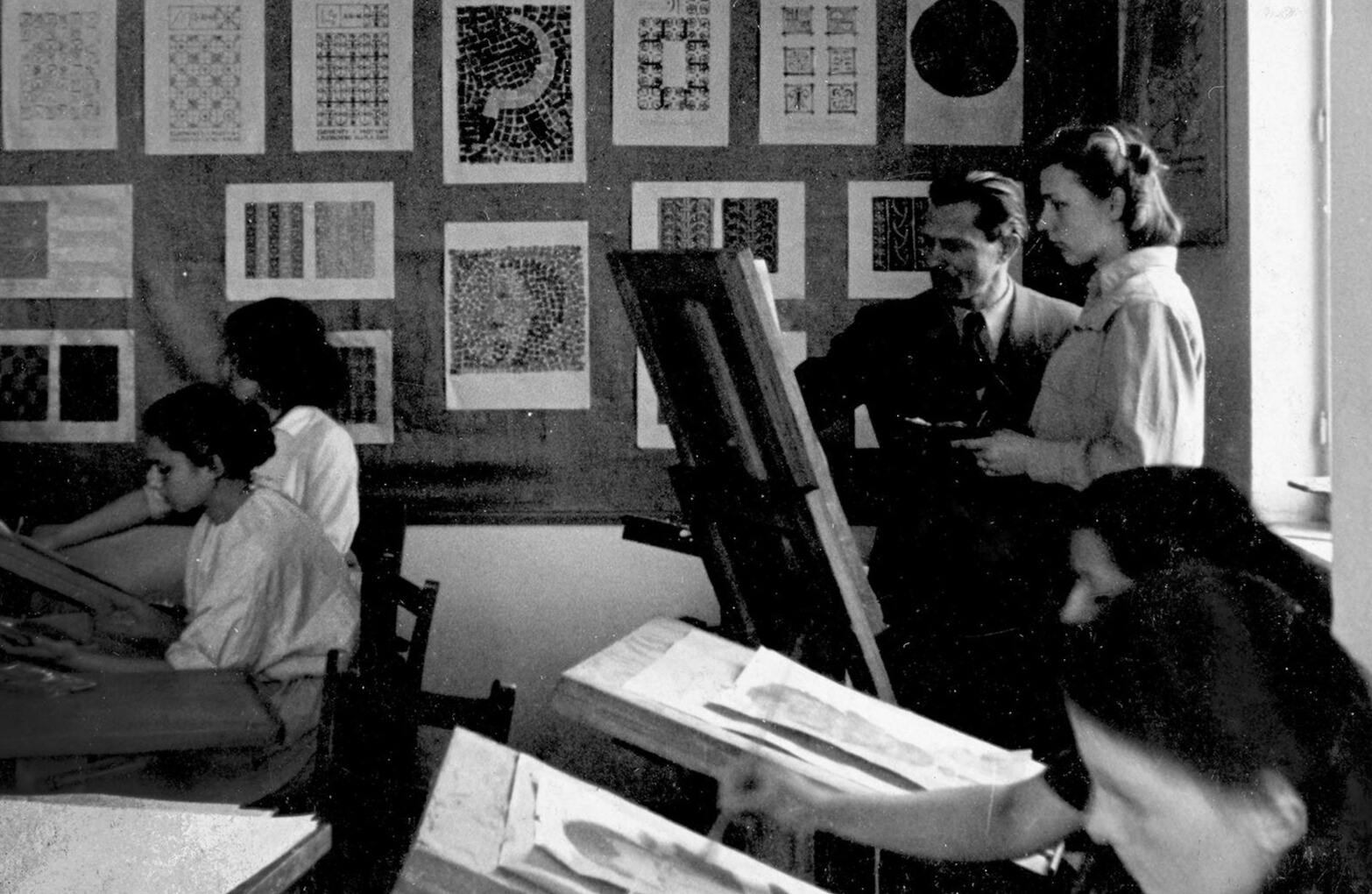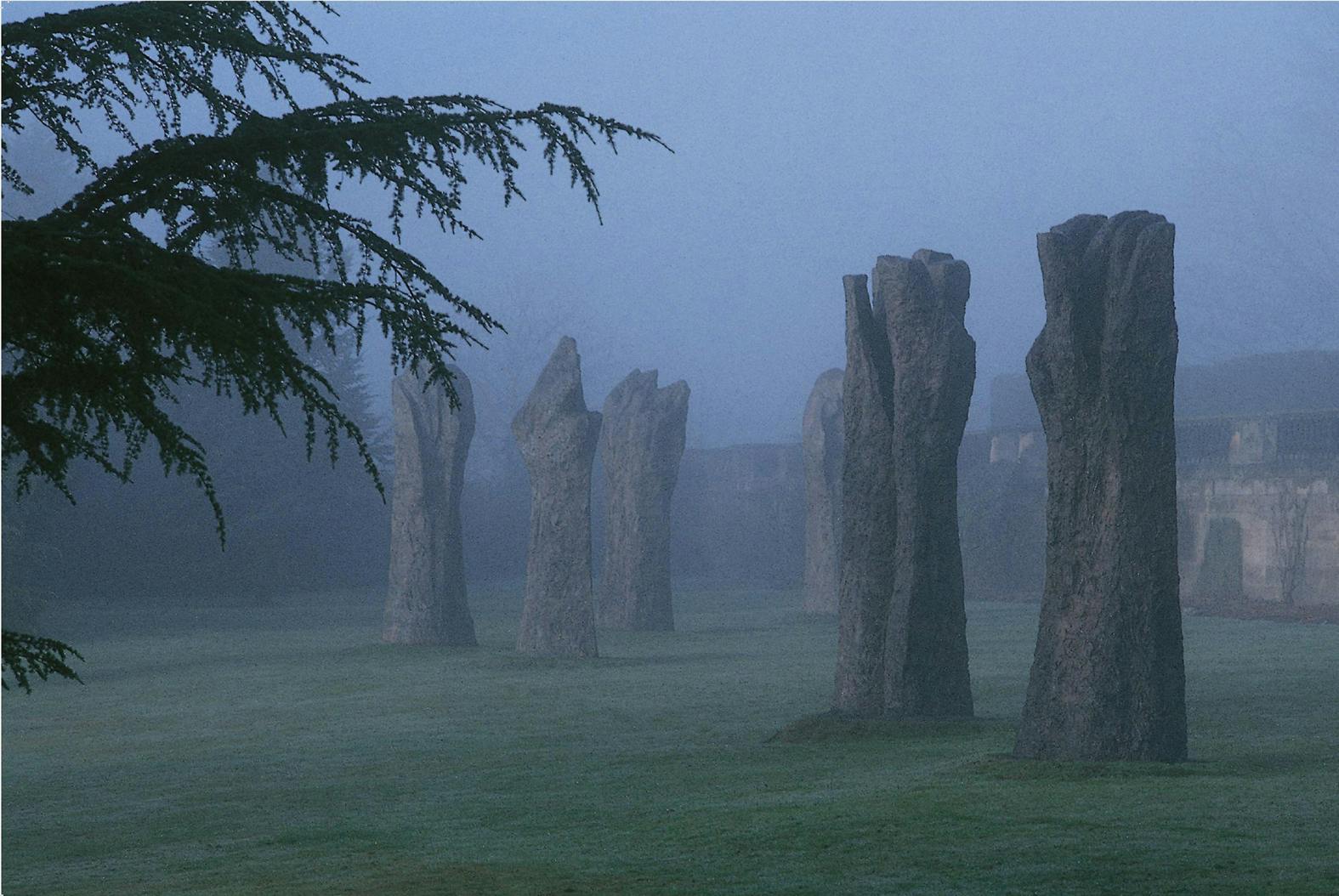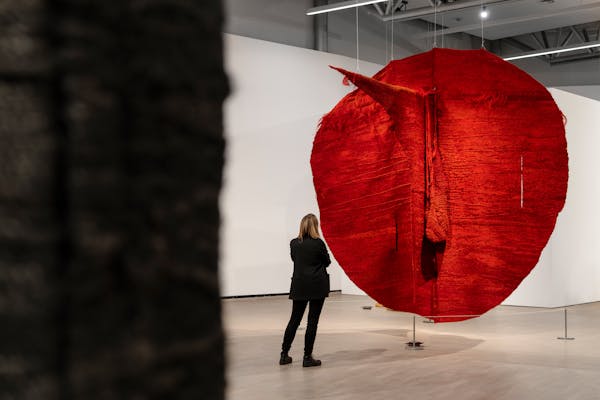Timeline: Magdalena Abakanowicz (1930-2017)

Magdalena Abakanowicz in 1968.
Timeline: Magdalena Abakanowicz (1930-2017)
Learn more about Magdalene Abakanowicz's life and work, and how the Polish artist's creative approach and use of materials changed throughout her career.
"The war ended not for all. Under the Soviet domination we were seen as class enemies because of our aristocratic background. Some family members were deported to Russian gulags. No work for my parents, no school forme. How to avoid prison and punishment for the underground activity?"
– Magdalena Abakanowicz
1930-32
Marta Magdalena Abakanowicz is born in Falenty, a small village 11 kilometres southwest of Warsaw, in 1930. She is the second daughter of Konstanty – a landowner of Russian and Tartar heritage, and Helena – who is descended from Polish nobility.
When Abakanowicz is two years old, the family moves to her grandfather's 17th-century manor, set deep in the forest around 140 kilometres southeast of Warsaw. Their time is split between here and their house in Falenty.
1939
Nazi Germany invades Poland on the 1st of September 1939, and Soviet troops follow on the 17th of September. These invasions mark the beginning of the Second World War. At the outbreak of the war, the family settle in their forest estate and Abakanowicz is homeschooled.

Approx. 1939: The artist at her country home.
1943-44
German soldiers break into the manor house and wound Abakanowicz's mother. At the age of 14, Abakanowicz becomes a nurse's aid in a Warsaw hospital. The family flee the forest estate to Warsaw the following year, only to be separated during the turmoil of the Warsaw uprising by the Polish underground resistance. German reprisals lead to the complete destruction of Warsaw.
1945
At the demand of the Soviet Union, the second German Instrument of Surrender is signed in Berlin on the 8th of May marking the end of the Second World War in Eastern Europe.
1945-48
The family remain in Warsaw before relocating to Gdansk and transferring to middle school there. She progresses to secondary school in Gdynia and takes a trip to Wroclaw to see the Exhibition of Regained Territories. She encounters works by artists using non-traditional art-making materials and is impressed by large scale installations by Stanis!aw Zamecznik (1909-71) and Henryk Stazewski (1894-1988).

The artist (standing) at a secondary school for plastic arts, Gdynia, Poland.
1949-56
Abakanowicz enrols at the State Higher School of Fine Arts, Sopot. A year into her studies, the textile department at the school is closed and she transfers to the Academy of Plastic Arts in Warsaw.
She uses her middle name, Magdalena, to disguise her landowner roots for fear of being exposed as a dass enemy in Communist Poland. She meets Jan Kosmowski (1930-2018), an engineer studying at the Warsaw University of Technology. They marry in 1956.

1950: Handwritten application to transfer to th Academy of Fine Arts, Warwaw.
I would like to apply for admission to the second year of studies. My request is motivated by the closure of the tapestry department at PWSSP in Sopot, where I undertook my first year of study. Tapestry is the field in which I want to specialize. I have relatives living in Warsaw and I can count on their hospitality.
Archives of the Academy of Fine Arts in Warsaw.

1956: Abakanowicz and her husband, Jan Kosmowski, at their wedding reception.
1957
Travels outside of Poland for the first time on a two-week trip to ltaly, organized by the Association of Polish Artists and Designers.
1960
First solo exhibition at Ministry of Art and Culture's Galeria Kordegarda in Warsaw. The show is closed by Polish authorities before it can open to the public.
"The first show – what an excitement. I came one hour before the opening to check all the details. I could not enter: the door was locked ... The next day we learned that the authorities found the show to be 'formalistic,' that means not engaged with building socialism. The show was closed before it ever opened. We realized that the 'thaw' that had come after Stalins death was over. The old rules returned."
– Magdalena Abakanowicz
"I like neither rules nor instructions, these are enemies of imagination. I make use of the technique of weaving by adapting it to my own ideas. My art has always been a protest against what I have met with in weaving."
– Magdalena Abakanowicz

1964: Zwierciadło magazine (351. 6, 9th of Febuary, 1964). Article by Elżbieta Żmudzka, in which the term "Abakans" is used for the first time.
1960-70 FINDING HER PLACE
Abakanowicz begins to find her own artistic language, resisting the pre-defined categories of "craft'', "textiles" and "fine art". She is recognised for her efforts and exhibits internationally.
"I never felt that my studio was small, except when I had to move big pieces out of it, I had to go through the window on the 10th floor. I had an enormous view through my windows and lived more in this view than in the room. Mentally, I was still in Polish forests in the Polish country which I love in an extremely strong way because I know every end, I know every leaf, I know every piece of grass... This has been my world since childhood".
– Magdalena Abakanowicz
1962
Maria laszkiewicz (1891-1981), a Polish professional weaver, nominates Abakanowicz to represent Poland in the 1st International Tapestry Biennial in Lausanne, Switzerland. This will be Abakanowicz's first international exhibition, as one ofthree polish weavers. In the same year, she secures her first solo show outside of Poland, Magdalena Abakanowicz: Tapestries, at Galerie Dautzenberg, Paris.
1964
Exhibits in the VIII Bienal de São Paulo, Brazil, along with artist weavers Jolanta Owidzka (1927-2020) and Wojciech Sadley (b. 1932). Abakanowicz builds a special loom with laszkiewicz and hires Stefania Zgudka, a sixteen-year-old graduate of the Vocational School of Arts and Crafts in Zakopane, as an assistant. Abakanowicz creates five large-scale wall hangings for the exhibition and is awarded the Gold Medal in Applied Arts.
Around the same time, the term "Abakan" is coined by art critic Elzbieta Zmudzka. While initially ascribed to wall-mounted, rectangular works, after a year or so the artist begins to use Abakans herself to refer to her three-dimensional woven works.

Postcard to Abakanowicz from Ryszard Stanislawski (Director, Muzeum Sztuki w Łodzi and Commissioner, Polish Section, 8th Sao Paulo Biennial), 1965
Dear Miss Magdalena,
From the bottom of my heart I want to congratulate you on your success at the biennal: GOLD MEDAL.
Equal prize as in painting, sculpture, ect. I am very glad about that. I will tell you all the details in person when we meet on 20 Sept. or a bit later, because I will stay for a few days in Paris.
Best,
Ryszard Stanisławski
1965
Using the prize money from the biennale, Abakanowicz and her husband move to a cooperative housing block in Warsaw. Featuring artist studios on the top floor, the couple will live and work here until 1989. The artist is appointed a professor at the State University School of Plastic Arts in Poznań.
1967
The artist produces her first fully three-dimensional forms, dubbed Abakans. No longer restricted by the walls of a gallery, they are suspended freely in space.

Mid-1960s: Artist teaching at Państwowa Wyższa Szkoła Sztuk Plastycznych (State Higher School of Plastic Arts) in Poznań in Poland.
Photo: Jerzy Nowakowski
1969-70
With film director Jarostaw Brzozowski (1911-69) and experimental composer Bogustaw Schaffer 1929-2019), Abakanowicz creates the film Abakany on the sand dunes along the Baltic coast of Poland.

Approx. 1968: Artist's studio in Warsaw. Abakan Open 1967-68 and Abakan Yellow 1967-68.
Photo: Estate of Marek Holzman
"Arboreals symbolise our concern with nature which, neglected and abused by man, now turns against him with vengeance. They remind us that a tree is our friend: it gives shade and oxygen, bears fruit, shelter birds and animals, and makes climate hospitable to all".
– Magdalena Abakanowicz
1970-80 CREATING EXPERIENCES
Abakanowicz begins to envision her works not as discrete objects but rather as environments formed within a given space. The use of rope becomes a repeated motif. In the 1970s she has 21 solo shows and participates in over 75 group exhibitions in Poland and worldwide.
1970
Her first installation project – a massive temporary work built of Abakans and rope - takes place at the Södertälje Konsthall in Sweden.
She receives her first major public commission in the province of Noord-Brabant in 's-Hertogenbosch, the Nederlands. Abakanowicz creates a spatial installation named Bois le Duc from a cluster of hanging textile panels. 26 feet tall and dark reddish-brown in colour, the panels are intended to evoke a grove of ancient trees.

1970: Exhibition view from Magdalena Abakanowicz: Textile Sculpture, Textile Environment, Södertälje Konsthall, Sweden.
Photo: Abakanowicz Arts and Culture Charitable Foundation / Jan Nordahl
1971
Travels to California to undertake her first solo show in the USA, at the Pasadena Art Museum. The larger exhibition space grants Abakanowicz the opportunity to experiment with the placing of her works, in relation to each other and to the gallery itself. She also incorporates found objects – such as a large piece of rope procured from the local harbour.
1972
Abakanowicz is invited to show at Atelier '72: Edinburgh International Festival i Edinburgh, Scotland. After discovering that the exhibition space is too small to show her larger works. Abakanowicz decides to use a massive length of painted red rope as a thread to connect the exhibition space of the Richard Demarco Gallery to the neighbouring St Mary's Cathedral.

1972: Artist in front of Bois le Duc, Provinciehuis van Noord-Brabant, 's-Hertogenbosch, the Netherlands.
Photo: Jan Nordahl / Abakanowicz Arts and Culture Charitable Foundation
1976
Creates the exhibitions Organic Structures and Soft Forms at the Art Gallery of New South Wales, Sydney, which travels to Melbourne. Two films are produced about Abakanowicz while she is in Australia. She also gives lectures and stages workshops.
1977
Writes an autobiographical prose poem called Portrait x 20, which is published by Abbeville Press. The poem narrates Abakanowicz's childhood experiences, including her early relationship with nature and the hardship suffered during World War II.
The exhibition Magdalena Abakanowicz. Organic Structures takes place at Henie Onstad Kunstsenter.
"With my exhibitions around the world, I wanted to make people aware of that my captive country still has a high level of old culture contributing to the world heritage, and is at the same time able to speak about the recent reality with the very personal and powerful voice of modern art... I have travelled probably more than any other artists. That important was the dialogue with the whole world".
– Magdalena Abakanowicz
1980-1992 SITES OF CONTEMPLATION
The artist embarks on a series of major public sculptures and commissions around the world. She responds to the landscape and historical makeup of each individual site, varying her forms and choice of materials accordingly.
1980
Abakanowicz represents Poland at the Venice Biennale. Her space is structured as a complete environment, including outdoor sculptures recalling traditional Tatar tents, the soft organic forms of Embryology 1978-81, and 40 burlap sacks turned into Backs 1976-79/80. Rope is used to bind the various works together.
On 31st of August 1980, Solidarity, the first independent trade union in a Soviet Bloc country, is officially formed in opposition to the Polish government. The movement is led by Lech Walesa (b. 1943), who was elected President of Poland in 1990. Abakanowicz's husband, Jan, is involved in the movement.

1980: The Polish Pavilion, Venice Bienniale 1980, showing artists with Backs 1976-79.
Photo: Artur Starewicz / East News

1981: View of the city from the artist's studio in Warsaw.
Photo: Artur Starewicz / East News

1978-80: Portrait x 20. Typescript of the first draft of the English translation, 1982.
Courtesy Libary and Archives Collection, Museum of Contemporart Art Chicago. Photo: Artur Starewicz / East News

1982: Installation photo, Museum of Contemporart Art, Chicago, showing Heads 1973-75 and Seated Figures 1974-79.
Photo: Artur Starewicz / East News
1985
At the invitation of collector Giuliano Gori, Abakanowicz undertakes her first major permanent outdoor installation for the sculpture park, Spazi d'Arte in Tuscany, Italy. Katarsis (1985) is a group of 33 bronze standing figures. It is the artist's first work using bronze.

1985: Katarsis, 33 figures in bronze. Giuliano Gori Collection, Fattoria di Celle, Santomato di Pistoia, Italy.
Photo: Artur Starewicz / East News
1987
Creates Negev at the Billy Rose Sculpture Garden, Israel Museum, Jerusalem. Impressed by the quality of the local limestone, which is filled with fossils, Abakanowicz carves a group of seven monumental 12-tonne wheels.
1987
Abakanowicz begins the series War Games (1987-95). Coming across felled trees in Poland's Masurian Lake District, she creates a total of 21 huge forms from the discarded trunks.

1987: The artist working on War Games 1987-1995 the Masurian Lake district in Poland. Photo: Artur Starewicz / East News

1987: Negev, seven wheels in limestone.
Collection Israel Museum, Billy Rose Art Garden, Jerusalem.
Photo: Artur Starewicz / East News.
1988
Commissioned to make a permanent public work for the Seoul 1998 Olympic Games. Space of Dragon consists of ten massive bronze animal heads.

1989: Sacrophagi in Glass House, made from wood, glass and iron.
Collection Storm King Art Center, Moutainville, New York. Foto: Nobert Piwowarczyk / Abakanowicz Arts and Culture Charitable Foundation.
1990
Under President François Mitterrand (1916-96), a programme is launched to redesign La Défense, a business district in Paris. Abakanowicz proposes Bois de Nanterre, her vision of a vertical garden, residential and commercial tower. The proposal would go on to form her series Arboreal Architecture.
1991
The Soviet Union is dissolved on the 25th of December 1991, with its constituent republics gaining full sovereignty the following day.
"I use the tree as a metaphor for the ecological architecture of the 21st century, just as the human body served as a metaphor for the shape of a Romanesque cathedral".
– Magdalena Abakanowicz
1992
A petition requesting that Abakanowicz be commissioned to create a permanent installation is signed by over 6,000 Japanese citizens. She is offered a site at the Hiroshima City Museum of Contemporary Art. It is agreed the monument should be forty silent seated Backs in bronze.
1993-2020 FACING HUMANITY
In her later works, Abakanowicz meditates on human nature and the capacity for violence, particulary in relation to nature. Through her project Arboreal Architecture, she imagines a new dynamic, which seeks to reconcile the organic world with modern metropolitan life.
1993
Shows War Games at The Institue for Contemporart Art, P.S.1, New York (now MoMA PS1).
1995
Magdalena Abakanowicz: Bronze Sculpture opens at the Yorkshire Sculpture Park in the UK. The show features Hand-like Trees (1994), from the project Arboreal Architecture.

1995: Yorkshire Sculpture Park, Wakefield, UK, showing Hand-like Trees 1994.
Photographer: Clare Lilley

1998: Space of Unknown Growth, Europos Parkas, Vilnius, Lithuania.
Photographer: Norbert Piwowarczyk / Abakanowicz Arts and Culture Charitable Foundation
1998
With Gintaras Karosas (1968-), artist and founder of Europos Parkas, Open-Air Museum of the Centre of Europe, near Vilnius in Lithuania, she creates Space of Unknown Growth (1998).
The work consists of huge concrete ovoid forms placed around the site. Of the work, the artist writes that "here the imagination of man meets the wisdom of nature".
Abakanowicz receives Poland's greatest honour, the Order of Polonia Restituta.
2002
Unrecognized (2002) is built in Park Cytadela, Poznań in Poland, a public project urged on by former students of the artists. The works consists of 112 headless iron figures, standing two metres tall.
2004
On the 1th of May 2004 Poland joins the European Union.
2006
Abakanowicz completes Agora for Grant Park, Chicago, Illinois. Begun in 2004, this is the largest – and last – permanent public project executed by the artist: 106 headless figures, cast in iron and standing tall.

2006: Agora, 106 cast iron figures installed at Grand Park, Chicago.
"We live in times which are exstraordinary because of their various forms of aggression. Today new danger exists around us as if everyone where against everyone. Agora should become a symbol, a metaphor about this particular historical moment in which we need each other, in which we want to rely on each other more than ever".
– Magdalena Abakanowicz
2009
Magdalena Abakanowicz: Space to Experience opens at the Fondazione Arnaldo Pomodoro in Milan, one of the last exhibitions in which the artists plays an active role in shaping.
2017
Abakanowicz dies of complications from Alzheimer's in Warsaw in Poland, on the 20th of April. She is buried in the Powązki Cemetery, the oldest in the city.
2020
The University of Art in Poznań, where Abakanowicz taught for several decades, is renamed in honour of the artists to the Magdalena Abakanowicz University of Arts in Poznań.

Detail of Sacrophagi in Glass House.




